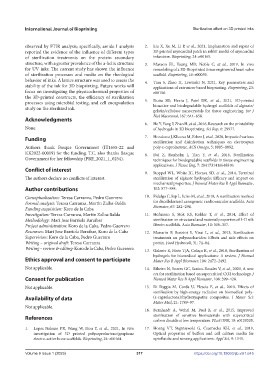Page 325 - IJB-9-1
P. 325
International Journal of Bioprinting Sterilization effect on 3D printed inks
observed by FTIR analysis; specifically, amide I analysis 2. Liu X, Xu M, Li P, et al., 2021, Implantation and repair of
reported the evidence of the influence of different types 3D printed myocardial patch in rabbit model of myocardial
of sterilization treatments on the protein secondary infarction. Bioprinting, 24: e00165.
structure, with a greater prevalence of the a-helix structure 3. Maxson EL, Young MD, Noble C, et al., 2019, In vivo
for UV inks. The current study has shown the influence remodeling of a 3D-Bioprinted tissue engineered heart valve
of sterilization processes and media on the rheological scaffold. Bioprinting, 16: e00059.
behavior of inks. A lattice structure was used to assess the 4. Tian S, Zhao H, Lewinski N, 2021, Key parameters and
stability of the ink for 3D bioprinting. Future works will applications of extrusion-based bioprinting. Bioprinting, 23:
focus on investigating the physicochemical properties of e00156.
the 3D-printed constructs, the efficiency of sterilization
processes using microbial testing, and cell encapsulation 5. Dutta SD, Hexiu J, Patel DK, et al., 2021, 3D-printed
bioactive and biodegradable hydrogel scaffolds of alginate/
study on the sterilized ink. gelatin/cellulose nanocrystals for tissue engineering. Int J
Biol Macromol, 167: 644–658.
Acknowledgments
6. He Y, Yang F, Zhao H, et al., 2016, Research on the printability
None. of hydrogels in 3D bioprinting. Sci Rep, 6: 29977.
Funding 7. Horakova J, Klicova M, Erben J, et al., 2020, Impact of various
sterilization and disinfection techniques on electrospun
Authors thank Basque Government (IT1658-22 and poly-ε-caprolactone. ACS Omega, 5: 8885–8892.
KK2022-00019) for the funding. T.C. also thanks Basque 8. Dai Z, Ronholm J, Tian Y, et al., 2016, Sterilization
Government for her fellowship (PRE_2021_1_0254). techniques for biodegradable scaffolds in tissue engineering
applications. J Tissue Eng, 7: 2041731416648810.
Conflict of interest
9. Stoppel WL, White JC, Horava SD, et al., 2014, Terminal
The authors declare no conflicts of interest. sterilization of alginate hydrogels: Efficacy and impact on
mechanical properties. J Biomed Mater Res B Appl Biomater,
Author contributions 102: 877–884.
Conceptualization: Teresa Carranza, Pedro Guerrero 10. Fidalgo C, Iop L, Sciro M, et al., 2018, A sterilization method
Formal analysis: Teresa Carranza, Martin Zalba-Balda for decellularized xenogeneic cardiovascular scaffolds. Acta
Funding acquisition: Koro de la Caba Biomater, 67: 282–294.
Investigation: Teresa Carranza, Martin Zalba-Balda 11. Hofmann S, Stok KS, Kohler T, et al., 2014, Effect of
Methodology: Mari Jose Barriola Baraibar sterilization on structural and material properties of 3-D silk
Project administration: Koro de la Caba, Pedro Guerrero fibroin scaffolds. Acta Biomater, 10: 308–317.
Resources: Mari Jose Barriola Baraibar, Koro de la Caba 12. Munarin F, Bozzini S, Visai L, et al., 2013, Sterilization
Supervision: Koro de la Caba, Pedro Guerrero treatments on polysaccharides: Effects and side effects on
Writing – original draft: Teresa Carranza pectin. Food Hydrocoll, 31: 74–84.
Writing – review & editing: Koro de la Caba, Pedro Guerrero 13. Galante R, Pinto TJA, Colaço R, et al., 2018, Sterilization of
hydrogels for biomedical applications: A review. J Biomed
Ethics approval and consent to participate Mater Res B Appl Biomater, 106: 2472–2492.
Not applicable. 14. Ribeiro N, Soares GC, Santos-Rosales V, et al., 2020, A new
era for sterilization based on supercritical CO2 technology. J
Consent for publication Biomed Mater Res B Appl Biomater, 108: 399–428.
Not applicable. 15. Di Foggia M, Corda U, Plescia E, et al., 2010, Effects of
sterilisation by high-energy radiation on biomedical poly-
Availability of data (ε-caprolactone)/hydroxyapatite composites. J Mater Sci:
Mater Med, 21: 1789–97.
Not applicable.
16. Bernhardt A, Wehrl M, Paul B, et al., 2015, Improved
References sterilization of sensitive biomaterials with supercritical
carbon dioxide at low temperature. PLoS ONE, 10: e0129205.
1. Lopes Nalesso PR, Wang W, Hou Y, et al., 2021, In vivo 17. Hoang VT, Stępniewski G, Czarnecka KH, et al., 2019,
investigation of 3D printed polycaprolactone/graphene Optical properties of buffers and cell culture media for
electro-active bone scaffolds. Bioprinting, 24: e00164. optofluidic and sensing applications. Appl Sci, 9: 1145.
Volume 9 Issue 1 (2023) 317 https://doi.org/10.18063/ijb.v9i1.645

